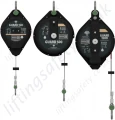
- Lifting Equipment
-
Height Safety

Height Safety Equipment
- Material Handling & Jacking Equipment
- Shop by Brand
- Clearance
-
Contact
Get In Touchsales@liftingsafety.co.uk +44 (0)1977 684 600
- Home/
- Lifting Equipment/
- Specialist Lifting Equipment/
- Load Arrestors/
- Neofeu Load arrestors from 200kg to 5000kg /
- Neofeu NCHL Series / Big Series Load Arrestors - 300kg to 5000kg Models
Neofeu load arresters work on both static and moving loads through their automatic retracting cable. They consist of an efficient solution in many fields of application to automatically arrest the fall of a load. They offer additional protection in case of failure of the primary system intended to restrain or transport the loads. In such a case, the brake activates and locks the load on a short distance (a few centimetres).
Features: NCHL Load Arrestor Series
- Steel casing epoxy-treated.
- Zinc-plated screws and bolts.
- Quick locking brake with two pawls.
- Galvanised steel cable.
- Standard locking speed: 20 m/min (Factory setting on request)
Technical Specifications
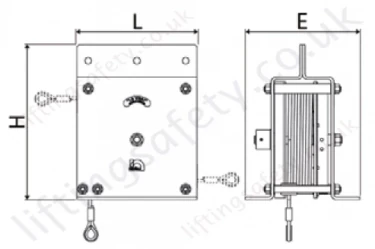 |
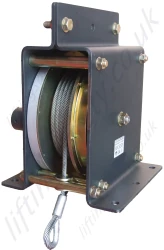 |
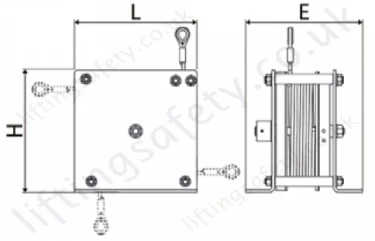 |
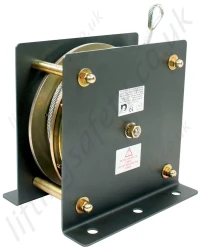 |
| Neofeu NCHL Series / Big Series Load Arrestor - Version 1 | Neofeu NCHL Series / Big Series Load Arrestor - Version 2 | ||
| Model | Max. Load (kg) | Max. Cable Length (m) | L (mm) | Version 1: H (mm) | Version 2: H (mm) | E (mm) |
| NCHL300/25 | 300 | 25 | 330 | 428 | 328 | 263 |
| NCHL300/40 | 300 | 40 | 330 | - | 328 | 298 |
| NCHL500/20 | 500 | 20 | 330 | 428 | 328 | 263 |
| NCHL500/30 | 500 | 30 | 330 | - | 328 | 298 |
| NCHL1000/12 | 1000 | 12 | 370 | 480 | 370 | 353 |
| NCHL1000/25 | 1000 | 25 | 455 | 565 | - | 336 |
| NCHL1500/10 | 1500 | 10 | 370 | 480 | 370 | 353 |
| NCHL1500/25 | 1500 | 25 | 455 | 565 | - | 336 |
| NCHL2000/10 | 2000 | 10 | 370 | 480 | 370 | 353 |
| NCHL2000/20 | 2000 | 20 | 620 | 735 | 640 | 390 |
| NCHL2500/10 | 2500 | 10 | 370 | 480 | 370 | 353 |
| NCHL2500/17 | 2500 | 17 | 620 | 735 | 640 | 390 |
| NCHL3000/15 | 3000 | 15 | 620 | 735 | 640 | 390 |
| NCHL4000/10 | 4000 | 10 | 620 | 735 | 640 | 390 |
| NCHL5000/10 | 5000 | 10 | 600 | 735 | 640 | 390 |
What is a load arrestor?
A load arrestor is pretty much a block that has a lot in common with regular safety blocks. The big difference is that Load Arrestors are built and designed to arrest loads instead of people.
In other words, Load Arrestors are used as a backup safety system which provides independent protection that will arrest the fall of a load in the event of the primary systems failing. It reduces the risk of equipment damage and protects personnel in and around the danger zone.
About Load Arrestors
In any industry, you will find lots of lifting devices that could lose their load in case of a broken chain, motor axle, etc. The same goes for safety doors, nuclear plants, heavy tools hanging in balance blocks, etc. Load Arrestors can be used in almost unlimited situations. They give the customer a second safety backup and ensure that personnel or loads are not at risk in a fall.
Load Arrestors are very reliable and if inspected and maintained, could last 20 years +.
Neofeu load arresters work on both static and moving loads through their automatic retracting cable. They consist of an efficient solution in many fields of application to automatically arrest the fall of a load. They offer additional protection in case of failure of the primary system intended to restrain or transport the loads. In such a case, the brake activates and locks the load on a short distance (a few centimetres).
Features: NCHL Load Arrestor Series
- Steel casing epoxy-treated.
- Zinc-plated screws and bolts.
- Quick locking brake with two pawls.
- Galvanised steel cable.
- Standard locking speed: 20 m/min (Factory setting on request)
Technical Specifications
 |
 |
 |
 |
| Neofeu NCHL Series / Big Series Load Arrestor - Version 1 | Neofeu NCHL Series / Big Series Load Arrestor - Version 2 | ||
| Model | Max. Load (kg) | Max. Cable Length (m) | L (mm) | Version 1: H (mm) | Version 2: H (mm) | E (mm) |
| NCHL300/25 | 300 | 25 | 330 | 428 | 328 | 263 |
| NCHL300/40 | 300 | 40 | 330 | - | 328 | 298 |
| NCHL500/20 | 500 | 20 | 330 | 428 | 328 | 263 |
| NCHL500/30 | 500 | 30 | 330 | - | 328 | 298 |
| NCHL1000/12 | 1000 | 12 | 370 | 480 | 370 | 353 |
| NCHL1000/25 | 1000 | 25 | 455 | 565 | - | 336 |
| NCHL1500/10 | 1500 | 10 | 370 | 480 | 370 | 353 |
| NCHL1500/25 | 1500 | 25 | 455 | 565 | - | 336 |
| NCHL2000/10 | 2000 | 10 | 370 | 480 | 370 | 353 |
| NCHL2000/20 | 2000 | 20 | 620 | 735 | 640 | 390 |
| NCHL2500/10 | 2500 | 10 | 370 | 480 | 370 | 353 |
| NCHL2500/17 | 2500 | 17 | 620 | 735 | 640 | 390 |
| NCHL3000/15 | 3000 | 15 | 620 | 735 | 640 | 390 |
| NCHL4000/10 | 4000 | 10 | 620 | 735 | 640 | 390 |
| NCHL5000/10 | 5000 | 10 | 600 | 735 | 640 | 390 |
What is a load arrestor?
A load arrestor is pretty much a block that has a lot in common with regular safety blocks. The big difference is that Load Arrestors are built and designed to arrest loads instead of people.
In other words, Load Arrestors are used as a backup safety system which provides independent protection that will arrest the fall of a load in the event of the primary systems failing. It reduces the risk of equipment damage and protects personnel in and around the danger zone.
About Load Arrestors
In any industry, you will find lots of lifting devices that could lose their load in case of a broken chain, motor axle, etc. The same goes for safety doors, nuclear plants, heavy tools hanging in balance blocks, etc. Load Arrestors can be used in almost unlimited situations. They give the customer a second safety backup and ensure that personnel or loads are not at risk in a fall.
Load Arrestors are very reliable and if inspected and maintained, could last 20 years +.
You May Also Like
Contact Us About This Product
If you wish to receive a quote for this product, please use the tab above, this form is for general enquiries regarding this product only.
You can also Request a Quote using the Quote tab above!
You can easily add more than one item to the Quote Request. This is highly recommended as we will be able to suit your needs much more efficiently.
Share this page!




